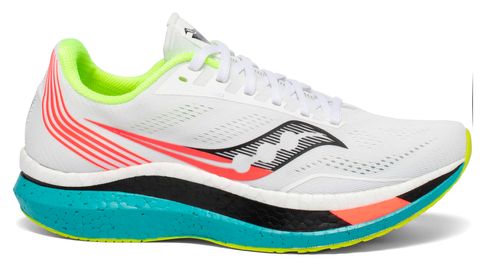You can trust Coach
For the first time since I picked up a pair of Nike Vaporfly shoes in late 2018, I’m not completely sure which brand’s shoe I’m going to use for my next PB attempt. Until now, it’s generally been the case of picking between the Vaporfly 4% and Vaporfly NEXT%, – but even though I’ve used and loved Nike’s latest racer, the Alphafly, the Saucony Endorphin Pro might be the shoe I slip on.
That’s pretty much the best review you can give a running shoe at the moment – that it’s the match of Nike’s all-conquering racing line. However you feel about the ethics of high stack shoes with carbon plates, there’s no doubt that the Vaporfly has aided runners of all levels to achieve personal bests since its launch. You just have to glance down at the start lines of races to see Nike’s dominance, especially at the front of the pack.
Several brands have released shoes with carbon-fibre plates in 2020, so there was always a chance that sight would change when racing finally returns, but the Endorphin Pro is the first shoe I’ve tried that matches the performance of the Alphafly and Vaporfly. I loved the New Balance FuelCell TC as a Vaporfly-lite training shoe, but the like-for-like racing shoe, the New Balance FuelCell RC, hasn’t been made available yet. In my experience the first carbon plate options from Brooks and Asics – the Hyperion Elite and Metaracer – weren’t on Nike’s level, though I will caveat that by saying I need to log more miles in the Asics.
Interestingly, while New Balance has largely followed the Nike blueprint of a high stack of soft and bouncy foam combined with a carbon plate, Saucony has altered the formula slightly. The Endorphin Pro is well cushioned and of course has a plate, but the magic comes from the company’s SPEEDROLL technology that moves you from heel to toe in effortless fashion.
The feel of the ride is different, then. Not soft and bouncy, but absurdly smooth and a little firm. I still found the shoe comfortable for easy efforts and have no doubts it would feel the same over a marathon too.
I’ve used the Endorphin Pro for a range of runs, focusing mostly on speed sessions since it is a racing shoe first and foremost. It impressed me every time, from progression 10Ks to track-style intervals (without a track, since mine is shut) to a long run where I progressed from an easy pace to running around 3min 40sec/km for the last half hour. Every step has felt fluid and almost deceptively quick.

The shoe uses Saucony’s PWRRUN PB foam, which is PEBA-based like the ZoomX foam in the Vaporfly and Alphafly, though it has the polystyrene look of Adidas TPU Boost foam. The upper is comfortable and moulds nicely to the foot, and I have had no problems with rubbing or hotspots while using the Endorphin Pro, which fits true to size.
The outsole has minimal rubber on it as you’d expect on a racer, but there is enough there that durability shouldn’t be a major concern. My only real concern is that there is some exposed foam that could get ripped up a little if you run on even light trails. Sticking to the asphalt is going to be wise in this shoe.

On my last review run, I spent 90 minutes switching between the Endorphin Pro, the Alphafly and the Vaporfly every few kilometres. The Endorphin feels nimble and stable compared with the Alphafly, though both make holding a good pace that little bit easier. I’d put both ahead of the Vaporfly on that count, despite the Vaporfly being the lightest – my UK size nines weigh 198g for the Vaporfly, 229g for the Endorphin and 232g for the Alphafly.
For a full marathon, I might still lean towards the Alphafly for its extra cushioning and the softer feel of the ride. However, I think many runners will actually prefer the feel of the Saucony, especially since it is more stable, and both feels and looks more normal than the somewhat outlandish Alphafly. On a tricky course where you’re not just going to be on flat roads with few turns, that could give the Endorphin the edge.
The same might be true over shorter distances, especially 5Ks, though I have found that the Alphafly runs far lighter than it looks and is still a great 5K shoe.

That there is a decision to be made at all is testament to the Endorphin’s brilliance, and I do think it’s a more versatile shoe than the Alphafly. Add that to the fact that at £190 it’s £70 cheaper than the Alphafly and £50 cheaper than the Vaporfly, and you have a package that will appeal to an awful lot of runners who have been starved of top-tier non-Nike options of late.
Sadly, one other thing the Endorphin Pro has in common with the Vaporfly and Alphafly is how difficult it is to get hold of at the moment. However, since there aren’t any races to use it in anyway, you can wait a little longer for stocks to appear without missing out too much.
The other shoes in the Endorphin collection – the Speed, which is a fast training shoe with a TPU rather than carbon plate, and the Shift, which is for easy running and has PWRRUN+ foam in the midsole rather than PWRRUN PB – are both due to launch on 1st July, so there might well be more Pro shoes in stock then too.

Nick Harris-Fry is a journalist who has been covering health and fitness since 2015. Nick is an avid runner, covering 70-110km a week, which gives him ample opportunity to test a wide range of running shoes and running gear. He is also the chief tester for fitness trackers and running watches, treadmills and exercise bikes, and workout headphones.

This Expert PT Recommends Kettlebell Training For Strength, Power And Cardio Gains—And These Are The Six Exercises To Master First

I’ve Run The London Marathon Six Times—Here Are Four Ways To Set-Up Your Garmin Watch For A Better Race

Forget Crunches, This Exercise Is A Better Way To Build A Strong Core

